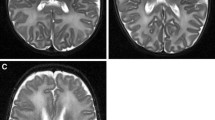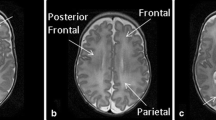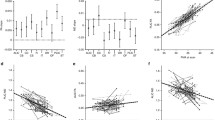Abstract
Background
Diffuse excessive high signal intensity (DEHSI) may represent damage to the white matter in preterm infants, but may be best studied alongside quantitative markers. Limited published data exists on its neuro-developmental implications.
Objective
The purpose of this study was to assess whether preterm children with DEHSI at term-corrected age have abnormal neuro-developmental outcome.
Materials and methods
This was a prospective observational study of 67 preterm infants with MRI of the brain around term-equivalent age, including diffusion-weighted imaging (DWI). Images were reported as being normal, overtly abnormal or to show DEHSI. A single observer placed six regions of interest in the periventricular white matter and calculated the apparent diffusion coefficients (ADC). DEHSI was defined as (1) high signal on T2-weighted images alone, (2) high signal with raised ADC values or (3) raised ADC values independent of visual appearances. The neuro-development was assessed around 18 months’ corrected age using the Bayley Scales of Infant and Toddler Development (3rd Edition). Standard t tests compared outcome scores between imaging groups.
Results
No statistically significant difference in neuro-developmental outcome scores was seen between participants with normal MRI and DEHSI, regardless of which definition was used.
Conclusion
Preterm children with DEHSI have similar neuro-developmental outcome to those with normal brain MRI, even if the definition includes objective markers alongside visual appearances.


Similar content being viewed by others
References
Wood NS, Marlow N, Costeloe K et al (2000) Neurologic and developmental disability after extremely preterm birth. N Engl J Med 343:378–384
Marlow N, Wolke D, Bracewell MA et al (2005) Neurologic and developmental disability at six years of age after extremely preterm birth. N Engl J Med 352:9–19
Fily A, Pierrat V, Delporte V et al (2006) Factors associated with neurodevelopmental outcome at 2 years after very preterm birth: the population-based Nord-Pas-de-Calais EPIPAGE cohort. Pediatrics 117:357–366
Bhutta AT, Cleeves MA, Casey PH et al (2002) Cognitive and behavioral outcomes of school-aged children who were born preterm. JAMA 288:728–737
Caravale B, Tozzi C, Albino G et al (2005) Cognitive development in low risk preterm infants at 3–4 years of life. Arch Dis Child Fetal Neonatal Ed 90:F474–F479
Reijneveld SA, de Kleine MJK, van Baar AL et al (2006) Behavioural and emotional problems in very preterm and very low birthweight infants at age 5 years. Arch Dis Child Fetal Neonatal Ed 91:F423–F428
Woodward LJ, Anderson PJ, Austin NC et al (2006) Neonatal MRI to predict neurodevelopmental outcomes in preterm infants. N Engl J Med 355:685–694
Aida N, Nishimura G, Hachiya Y et al (1998) MR imaging of perinatal brain damage: comparison of clinical outcome with initial and follow-up MR findings. AJNR 19:1909–1921
Serdaroglu G, Tekgul H, Kitis O et al (2004) Correlative value of magnetic resonance imaging for neurodevelopmental outcome in periventricular leukomalacia. Dev Med Child Neurol 46:733–739
Olsen P, Paakko E, Vainionpaa L et al (1997) Magnetic resonance imaging of periventricular leukomalacia and its clinical correlation in children. Ann Neurol 41:754–761
Hart AR, Whitby EH, Griffiths PD et al (2008) Magnetic resonance imaging and developmental outcome following preterm birth: review of current evidence. Dev Med Child Neurol 50:655–663
Inder TE, Wells SJ, Mogridge NB et al (2003) Defining the nature of the cerebral abnormalities in the premature infant; a qualitative magnetic resonance imaging study. J Pediatr 143:171–179
Hamrick SE, Miller SP, Leonard C et al (2004) Trends in severe brain injury and neurodevelopmental outcome in premature newborn infants: the role of cystic periventricular leukomalacia. J Pediatr 145:593–599
Volpe JJ (2001) Neurobiology of periventricular leukomalacia in the premature infant. Pediatr Res 50:553–562
Volpe JJ (2003) Cerebral white matter injury of the premature infant-more common than you think. Pediatrics 112:176–180
Back SA, Riddle A, McClure MM (2007) Maturation dependent vulnerability of perinatal white matter in premature birth. Stroke 38:724–730
Gilles FH, Gomez IG (2005) Developmental neuropathology of the second half of gestation. Early Hum Dev 81:245–253
Rutherford MA (2002) MRI of the neonatal brain. W.B.Saunders, London
Maalouf EF, Duggan PJ, Rutherford MA et al (1999) Magnetic resonance imaging of the brain in a cohort of extremely preterm infants. J Pediatr 135:351–357
Counsell SJ, Allsop JM, Harrison MC et al (2003) Diffusion-weighted imaging of the brain in preterm infants with focal and diffuse white matter abnormality. Pediatrics 112:1–7
Dyet LE, Kennea N, Counsell SJ et al (2006) Natural history of brain lesions in extremely preterm infants studied with serial magnetic resonance imaging from birth and neurodevelopmental assessment. Pediatrics 118:536–548
Counsell SJ, Rutherford MA, Cowan FM et al (2003) Magnetic resonance imaging of preterm brain injury. Arch Dis Child Fetal Neonatal Ed 88:F269–F274
Counsell SJ, Shen Y, Boardman JP et al (2006) Axial and radial diffusivity in preterm infants who have diffuse white matter changes on magnetic resonance imaging at term-equivalent age. Pediatrics 117:376–386
Skiold B, Horsch S, Hallberg B et al (2010) White matter changes in extremely preterm infants, a population-based diffusion tensor imaging study. Acta Paediatr 99:842–849
Hart AR, Smith MF, Rigby AS et al (2010) Appearances of diffuse excessive high signal intensity (DEHSI) on MR imaging following preterm birth. Pediatr Radiol 40:1390–1396
Hart AR, Whitby EH, Clark SJ et al (2010) Diffusion-weighted imaging of the cerebral white matter and cerebellum following preterm birth. Dev Med Child Neurol 52:652–659
Boardman JP, Counsell SJ, Rueckert D et al (2007) Abnormal deep grey matter development following preterm birth detected using deformation-based morphology. Neuroimage 32:70–78
Perneger TV (1998) What's wrong with Bonferroni adjustments? BMJ 316:1236–1238
Rigby AS (2010) Statistical recommendations for papers submitted to Developmental Medicine and Child Neurology. Dev Med Child Neurol 52:299–304
O'Shea TM, Kuban KCK, Allred EN et al (2008) Neonatal cranial ultrasound lesions and developmental delays at 2 years of age among extremely low gestational age children. Pediatrics 122:e662–e669
Holling EE, Leviton A (1999) Characteristics of cranial ultrasound white-matter echolucencies that predict disability: a review. Dev Med Child Neurol 41:136–139
de Vries LS, Van Haastert IC, Rademaker KJ et al (2004) Ultrasound abnormalities preceding cerebral palsy in high-risk preterm infants. J Pediatr 144:815–820
Miller SP, Cozzio CC, Goldstein RB et al (2003) Comparing the diagnosis of white matter injury in premature newborns with serial MR imaging and transfontanel ultrasonography findings. AJNR 24:1661–1669
Maalouf EF, Duggan PJ, Counsell SJ et al (2001) Comparison of findings on cranial ultrasound and magnetic resonance imaging in preterm infants. Pediatrics 107:719–727
Hagmann CF, De Vita E, Bainbridge A et al (2009) T2 at MR imaging is an objective quantitative measure of cerebral white matter signal intensity abnormality in preterm infants at term-equivalent age. Radiology 252:209–217
Krishnan ML, Dyet LE, Boardman JP et al (2007) Relationship between white matter apparent diffusion coefficients in preterm infants at term-equivalent age and developmental outcome at 2 years. Pediatrics 120:e604–e609
Schneider JF, Confort-Gouny S, Le Fur Y et al (2007) Diffusion-weighted imaging in normal fetal brain maturation. Eur Radiol 17:2422–2429
Huppi PS, Warfield S, Kikinis R et al (1998) Quantitative magnetic resonance imaging of brain development in premature and mature newborns. Ann Neurol 43:224–235
Hack M, Taylor HG, Drotar D et al (2005) Poor predictive validity of the Bayley Scales of Infant Development for cognitive function of extremely low birth weight children at school age. Pediatrics 116:333–341
Cornette LG, Tanner SF, Ramenghi LA et al (2002) Magnetic resonance imaging of the infant brain: anatomical characteristics and clinical significance of punctate lesions. Arch Dis Child 86:F171–F177
Miller SP, Ferriero DM, Leonard C et al (2005) Early brain injury in premature newborns detected with magnetic resonance imaging is associated with adverse early neurodevelopmental outcome. J Pediatr 147:609–616
Nanba Y, Matsui K, Aida N et al (2007) Magnetic resonance imaging regional T1 abnormalities at term accurately predict motor outcome in preterm infants. Pediatrics 120:e10–e19
Yung A, Poon G, Qui DQ et al (2007) White matter volume and anisotropy in preterm children: a pilot study of neurocognitive correlates. Pediatr Res 61:732–736
Counsell SJ, Edwards AD, Chew ATM et al (2008) Specific relations between neurodevelopmental abilities and white matter microstructure in children born preterm. Brain 131:3201–3208
Constable RT, Ment LR, Vohr BR et al (2008) Prematurely born children demonstrate white matter microstructural differences at 12 years of age, relative to term control subjects: an investigation of group and gender effects. Pediatrics 121:306–316
Andrews JS, Ben-Shachar M, Yeatman JD et al (2010) Reading performance correlates with white-matter properties in preterm and term children. Dev Med Child Neurol 52:e94–e100
Arzoumanian Y, Mirmiran M, Barnes PD et al (2003) Diffusion tensor brain imaging findings at term-equivalent age may predict neurologic abnormalities in low birth weight preterm infants. AJNR 24:1646–1653
Son SM, Park SH, Moon HK et al (2009) Diffusion tensor tractography can predict hemiparesis in infants with high risk factors. Neurosci Lett 451:94–97
Rose J, Mirmiran M, Butler EE et al (2007) Neonatal microstructural development of the internal capsule on diffusion tensor imaging correlates with severity of gait and motor deficits. Dev Med Child Neurol 49:745–750
Rose J, Butler EE, Lamont LE et al (2009) Neonatal brain structure on MRI and diffusion tensor imaging, sex and neurodevelopment in very-low-birthweight preterm children. Dev Med Child Neurol 51:526–535
Berman JI, Mukherjee P, Partridge JC et al (2005) Quantitative diffusion tensor MRI fiber tractography of sensorimotor white matter development in premature infants. Neuroimage 27:862–871
Partridge JC, Mukherjee P, Berman JI et al (2005) Tractography-based quantitation of diffusion tensor imaging parameters in white matter tracts of preterm newborns. J Magn Reson Imaging 22:467–474
Murakami A, Morimoto M, Yamada K et al (2008) Fiber-tracking techniques can predict the degree of neurologic impairment for periventricular leukomalacia. Pediatrics 122:500–506
Bassi L, Ricci D, Volzone A et al (2008) Probabilistic diffusion tractography of the optic radiations and visual function in preterm infants at term equivalent age. Brain 131:573–582
Acknowledgements
The authors wish to thank Dr Andrea Nussbaumer for her help with this study.
Financial disclosure
Dr Hart’s post is funded by a grant from the Jessop Baby Fund. The funding source had no involvement in study design, data collection, interpretation or decision to publish.
Conflicts of interest
No conflicts of interest are known.
Author information
Authors and Affiliations
Corresponding author
Rights and permissions
About this article
Cite this article
Hart, A., Whitby, E., Wilkinson, S. et al. Neuro-developmental outcome at 18 months in premature infants with diffuse excessive high signal intensity on MR imaging of the brain. Pediatr Radiol 41, 1284–1292 (2011). https://doi.org/10.1007/s00247-011-2155-7
Received:
Revised:
Accepted:
Published:
Issue Date:
DOI: https://doi.org/10.1007/s00247-011-2155-7




